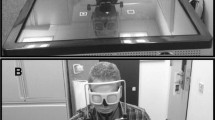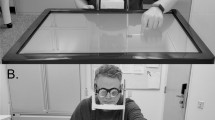Abstract
Previous research has indicated that rightward prism adaptation can reduce symptoms of spatial neglect following right brain damage. In addition, leftward prism adaptation can create “neglect-like” patterns of performance in healthy adults on tasks that measure attention and spatial biases. Although a great deal of research has focused on which behaviors are influenced by prism adaptation, very few studies have focused directly on how the magnitude of visual shift induced by prisms might be related to the observed aftereffects, or the effects of prisms on measures of attentional and spatial biases. In the current study, we examined these questions by having groups of healthy adult participants complete manual line bisection and landmark tasks prior to and following adaptation to either 8.5° (15 diopter; n = 22) or 17° (30 diopter; n = 25) leftward shifting prisms. Our results demonstrated a significantly larger rightward shift in straight-ahead pointing (a measure of prism aftereffect) following adaptation to 17°, compared to 8.5° leftward shifting prisms. In addition, only 17° leftward shifting prisms resulted in a significant rightward shift in line bisection following adaptation. However, there was a significant change in performance on the landmark task pre- versus post-adaptation in both the 8.5° and 17° leftward shifting prism groups. Interestingly, correlation analyses indicated that changes in straight-ahead pointing pre- versus post-adaptation were positively correlated with changes in performance on the manual line bisection task, but not the landmark task. These data suggest that larger magnitudes of prism adaptation seem to have a greater influence on tasks that require a response with the adapted hand (i.e., line bisection), compared to tasks that only require a perceptual judgment (i.e., the landmark task). In addition, these data provide further evidence that the effects of prisms on manual and perceptual responses are not related to one another.



Similar content being viewed by others
Notes
Note that in addition to testing 8.5° and 17° leftward shifting prisms groups, we also tested a 17° rightward shifting prisms group (n = 22) as a control. Although we were able to demonstrate a significant leftward aftereffect in straight-ahead pointing in the rightward shifting prisms group (pre = 1.09 vs. post = –2.58, p = .016, corrected), there were no significant changes in either LB (pre = –.74 vs. post = –1.03; F(1,21) = .824, p = .37) or the LM task (pre = 55 % vs. post = 53 %; F(1,21) = .28, p = .60) following rightward prism adaptation. This result is similar to previous studies that have failed to find significant effects of rightward shifting prisms on tests of attention and perceptual biases in healthy adults (e.g. Colent et al., 2000).
References
Berberovic N, Pisella L, Morris AP, Mattingley JB (2004) Prismatic adaptation reduces biased temporal order judgements in spatial neglect. Neuroreport 15(7):1199–1204. http://www.ncbi.nlm.nih.gov/entrez/query.fcgi?cmd=Retrieve&db=PubMed&dopt=Citation&list_uids=15129174
Bultitude JH, Woods JM (2010) Adaptation to leftward-shifting prisms reduces the global processing bias of healthy individuals. Neuropsychologia 48(6):1750–1756. doi:10.1016/j.neuropsychologia.2010.02.024
Buxbaum LJ, Ferraro MK, Veramonti T, Farné A, Whyte J, Ladavas E, Coslett HB (2004). Hemispatial neglect: subtypes, neuroanatomy, and disability. Neurology 62(5):749–756. http://www.ncbi.nlm.nih.gov/entrez/query.fcgi?cmd=Retrieve&db=PubMed&dopt=Citation&list_uids=15007125
Cherney LR, Halper AS (2001). Unilateral visual neglect in right-hemisphere stroke: a longitudinal study. Brain Injury 15(7):585–592. http://www.ncbi.nlm.nih.gov/entrez/query.fcgi?cmd=Retrieve&db=PubMed&dopt=Citation&list_uids=11429088
Colent C, Pisella L, Bernieri C, Rode G, Rossetti Y (2000) Cognitive bias induced by visuo-motor adaptation to prisms: a simulation of unilateral neglect in normal individuals? Neuroreport 11(9):1899–1902. http://www.ncbi.nlm.nih.gov/entrez/query.fcgi?cmd=Retrieve&db=PubMed&dopt=Citation&list_uids=10884040
Corbetta M, Shulman GL (2002) Control of goal-directed and stimulus-driven attention in the brain. Nat Rev Neurosci 3(3):201–215. http://www.ncbi.nlm.nih.gov/entrez/query.fcgi?cmd=Retrieve&db=PubMed&dopt=Citation&list_uids=11994752
Corbetta M, Patel G, Shulman GL (2008) The reorienting system of the human brain: from environment to theory of mind. Neuron 58(3):306–324. doi:10.1016/j.neuron.2008.04.017
Danckert J, Ferber S, Goodale MA (2008) Direct effects of prismatic lenses on visuomotor control: an event-related functional MRI study. Eur J Neurosci 28(8):1696–1704. doi:10.1111/j.1460-9568.2008.06460.x
Desmurget M, Grafton S (2000). Forward modeling allows feedback control for fast reaching movements. Trends Cognit Sci 4(11):423–431. http://www.ncbi.nlm.nih.gov/entrez/query.fcgi?cmd=Retrieve&db=PubMed&dopt=Citation&list_uids=11058820
Dijkerman HC, McIntosh RD, Milner AD, Rossetti Y, Tilikete C, Roberts RC (2003) Ocular scanning and perceptual size distortion in hemispatial neglect: effects of prism adaptation and sequential stimulus presentation. Exp Brain Res 153(2):220–230. http://www.ncbi.nlm.nih.gov/entrez/query.fcgi?cmd=Retrieve&db=PubMed&dopt=Citation&list_uids=12955382
Facchin A, Toraldo A, Daini R (2011) Adattamento prismatico con prismi di diverso potere. Giornale Italiano di Psicologia 38(1):27–145
Facchin A, Beschin N, Toraldo A, Cisari C, Daini R (2013) Aftereffect induced by prisms of different power in the rehabilitation of neglect: a multiple single case report. NeuroRehabilitation 32(4):839–853. doi:10.3233/NRE-130908
Farné A, Rossetti Y, Toniolo S, Ladavas E (2002) Ameliorating neglect with prism adaptation: visuo-manual and visuo-verbal measures. Neuropsychologia 40(7):718–729. http://www.ncbi.nlm.nih.gov/entrez/query.fcgi?cmd=Retrieve&db=PubMed&dopt=Citation&list_uids=11900724
Ferber S, Danckert J, Joanisse M, Goltz HC, Goodale MA (2003) Eye movements tell only half the story. Neurology 60(11):1826–1829. http://www.ncbi.nlm.nih.gov/entrez/query.fcgi?cmd=Retrieve&db=PubMed&dopt=Citation&list_uids=12796541
Girardi M, McIntosh RD, Michel C, Vallar G, Rossetti Y (2004). Sensorimotor effects on central space representation: prism adaptation influences haptic and visual representations in normal subjects. Neuropsychologia 42(11):1477–1487. http://www.ncbi.nlm.nih.gov/entrez/query.fcgi?cmd=Retrieve&db=PubMed&dopt=Citation&list_uids=15246285
Harvey M, Milner AD, Roberts RC (1995) An investigation of hemispatial neglect using the Landmark Task. Brain Cognit 27(1):59–78. http://www.ncbi.nlm.nih.gov/entrez/query.fcgi?cmd=Retrieve&db=PubMed&dopt=Citation&list_uids=7748546
Herlihey TA, Black SE, Ferber S (2012) Terminal, but not concurrent prism exposure produces perceptual aftereffects in healthy young adults. Neuropsychologia 50(12):2789–2795. doi:10.1016/j.neuropsychologia.2012.08.009
Husain M, Nachev P (2007) Space and the parietal cortex. Trends Cognit Sci 11(1):30–36. http://www.ncbi.nlm.nih.gov/entrez/query.fcgi?cmd=Retrieve&db=PubMed&dopt=Citation&list_uids=17134935
Husain M, Rorden C (2003) Non-spatially lateralized mechanisms in hemispatial neglect. Nat Rev Neurosci 4(1):26–36. http://www.ncbi.nlm.nih.gov/entrez/query.fcgi?cmd=Retrieve&db=PubMed&dopt=Citation&list_uids=12511859
Jewell G, McCourt ME (2000) Pseudoneglect: a review and meta-analysis of performance factors in line bisection tasks. Neuropsychologia 38(1):93–110. http://www.ncbi.nlm.nih.gov/entrez/query.fcgi?cmd=Retrieve&db=PubMed&dopt=Citation&list_uids=10617294
Karnath HO, Perenin MT (1998) Tactile exploration of peripersonal space in patients with neglect. Neuroreport 9(10):2273–2277. http://www.ncbi.nlm.nih.gov/entrez/query.fcgi?cmd=Retrieve&db=PubMed&dopt=Citation&list_uids=9694214
Karnath HO, Rorden C (2012) The anatomy of spatial neglect. Neuropsychologia 50(6):1010–1017. doi:10.1016/j.neuropsychologia.2011.06.027
Karnath HO, Niemeier M, Dichgans J (1998) Space exploration in neglect. Brain 121(Pt 12):2357–2367. http://www.ncbi.nlm.nih.gov/entrez/query.fcgi?cmd=Retrieve&db=PubMed&dopt=Citation&list_uids=9874486
Karnath HO, Ferber S, Himmelbach M (2001). Spatial awareness is a function of the temporal not the posterior parietal lobe. Nature 411(6840):950–953. http://www.ncbi.nlm.nih.gov/entrez/query.fcgi?cmd=Retrieve&db=PubMed&dopt=Citation&list_uids=11418859
Karnath HO, Fruhmann Berger M, Kuker W, Rorden C (2004) The anatomy of spatial neglect based on voxelwise statistical analysis: a study of 140 Patients. Cerebral Cortex. http://www.ncbi.nlm.nih.gov/entrez/query.fcgi?cmd=Retrieve&db=PubMed&dopt=Citation&list_uids=15142954
Kleinman JT, Newhart M, Davis C, Heidler-Gary J, Gottesman RF, Hillis AE (2007) Right hemispatial neglect: frequency and characterization following acute left hemisphere stroke. Brain Cognit 64(1):50–59. http://www.ncbi.nlm.nih.gov/entrez/query.fcgi?cmd=Retrieve&db=PubMed&dopt=Citation&list_uids=17174459
Learmonth G, Gallagher A, Gibson J, Thut G, Harvey M (2015) Intra- and inter-task reliability of spatial attention measures in pseudoneglect. PLoS ONE 10(9):e0138379. doi:10.1371/journal.pone.0138379
Loftus GR, Masson MEJ (1994) Using confidence intervals in within-subject designs. Psychon Bull Rev 1:476–490
Loftus AM, Vijayakumar N, Nicholls ME (2009) Prism adaptation overcomes pseudoneglect for the greyscales task. Cortex 45(4):537–543. doi:10.1016/j.cortex.2007.12.011
Luaute J, Michel C, Rode G, Pisella L, Jacquin-Courtois S, Costes N, Rossetti Y (2006) Functional anatomy of the therapeutic effects of prism adaptation on left neglect. Neurology 66(12):1859–1867. http://www.ncbi.nlm.nih.gov/entrez/query.fcgi?cmd=Retrieve&db=PubMed&dopt=Citation&list_uids=16801651
Luaute J, Schwartz S, Rossetti Y, Spiridon M, Rode G, Boisson D, Vuilleumier P (2009) Dynamic changes in brain activity during prism adaptation. J Neurosci 29(1):169–178. doi:10.1523/JNEUROSCI.3054-08.2009
Maravita A, McNeil J, Malhotra P, Greenwood R, Husain M, Driver J (2003) Prism adaptation can improve contralesional tactile perception in neglect. Neurology 60(11):1829–1831. http://www.ncbi.nlm.nih.gov/entrez/query.fcgi?cmd=Retrieve&db=PubMed&dopt=Citation&list_uids=12796542
Michel C (2006) Simulating unilateral neglect in normals: Myth or reality? Restor Neurol Neurosci 24:419–430
Michel C, Cruz R (2015) Prism adaptation power on spatial cognition: adaptation to different optical deviations in healthy individuals. Neurosci Lett 590:145–149. doi:10.1016/j.neulet.2015.02.001
Michel C, Pisella L, Halligan PW, Luaute J, Rode G, Boisson D, Rossetti Y (2003) Simulating unilateral neglect in normals using prism adaptation: implications for theory. Neuropsychologia 41(1):25–39. http://www.ncbi.nlm.nih.gov/entrez/query.fcgi?cmd=Retrieve&db=PubMed&dopt=Citation&list_uids=12427563
Michel C, Rossetti Y, Rode G, Tilikete C (2003). After-effects of visuo-manual adaptation to prisms on body posture in normal subjects. Exp Brain Res 148(2):219–226. http://www.ncbi.nlm.nih.gov/entrez/query.fcgi?cmd=Retrieve&db=PubMed&dopt=Citation&list_uids=12520410
Milner AD, Goodale MA (2006) The visual brain in action, 2nd edn. Oxford University Press, New York
Milner AD, Brechmann M, Pagliarini L (1992) To halve and to halve not: an analysis of line bisection judgements in normal subjects. Neuropsychologia 30(6):515–526. http://www.ncbi.nlm.nih.gov/entrez/query.fcgi?cmd=Retrieve&db=PubMed&dopt=Citation&list_uids=1641116
Mort DJ, Malhotra P, Mannan SK, Rorden C, Pambakian A, Kennard C, Husain M (2003) The anatomy of visual neglect. Brain 126(Pt 9):1986–1997. http://www.ncbi.nlm.nih.gov/entrez/query.fcgi?cmd=Retrieve&db=PubMed&dopt=Citation&list_uids=12821519
Nijboer TC, McIntosh RD, Nys GM, Dijkerman HC, Milner AD (2008) Prism adaptation improves voluntary but not automatic orienting in neglect. Neuroreport 19(3):293–298. http://www.ncbi.nlm.nih.gov/entrez/query.fcgi?cmd=Retrieve&db=PubMed&dopt=Citation&list_uids=18303569
Pisella L, Rode G, Farné A, Boisson D, Rossetti Y (2002) Dissociated long lasting improvements of straight-ahead pointing and line bisection tasks in two hemineglect patients. Neuropsychologia 40(3):327–334. http://www.ncbi.nlm.nih.gov/entrez/query.fcgi?cmd=Retrieve&db=PubMed&dopt=Citation&list_uids=11684165
Pisella L, Rode G, Farné A, Tilikete C, Rossetti Y (2006) Prism adaptation in the rehabilitation of patients with visuo-spatial cognitive disorders. Curr Opin Neurol 19(6):534–542. http://www.ncbi.nlm.nih.gov/entrez/query.fcgi?cmd=Retrieve&db=PubMed&dopt=Citation&list_uids=17102690
Redding GM, Wallace B (2006). Prism adaptation and unilateral neglect: review and analysis. Neuropsychologia 44(1):1–20. http://www.ncbi.nlm.nih.gov/entrez/query.fcgi?cmd=Retrieve&db=PubMed&dopt=Citation&list_uids=15907951
Redding GM, Rossetti Y, Wallace B (2005). Applications of prism adaptation: a tutorial in theory and method. Neurosci Biobehav Rev 29(3):431–444. http://www.ncbi.nlm.nih.gov/entrez/query.fcgi?cmd=Retrieve&db=PubMed&dopt=Citation&list_uids=15820548
Rode G, Rossetti Y, Boisson D (2001) Prism adaptation improves representational neglect. Neuropsychologia 39(11):1250–1254. http://www.ncbi.nlm.nih.gov/entrez/query.fcgi?cmd=Retrieve&db=PubMed&dopt=Citation&list_uids=11527562
Rossetti Y, Rode G, Pisella L, Farné A, Li L, Boisson D, Perenin MT (1998) Prism adaptation to a rightward optical deviation rehabilitates left hemispatial neglect. Nature 395(6698):166–169. http://www.ncbi.nlm.nih.gov/entrez/query.fcgi?cmd=Retrieve&db=PubMed&dopt=Citation&list_uids=9744273
Saj A, Cojan Y, Vocat R, Luaute J, Vuilleumier P (2013) Prism adaptation enhances activity of intact fronto-parietal areas in both hemispheres in neglect patients. Cortex 49(1):107–119. doi:10.1016/j.cortex.2011.10.009
Schindler I, McIntosh RD, Cassidy TP, Birchall D, Benson V, Ietswaart M, Milner AD (2009) The disengage deficit in hemispatial neglect is restricted to between-object shifts and is abolished by prism adaptation. Exp Brain Res 192(3):499–510. doi:10.1007/s00221-008-1585-4
Schintu S, Pisella L, Jacobs S, Salemme R, Reilly KT, Farne A (2014) Prism adaptation in the healthy brain: the shift in line bisection judgments is long lasting and fluctuates. Neuropsychologia 53:165–170. doi:10.1016/j.neuropsychologia.2013.11.013
Serino A, Angeli V, Frassinetti F, Ladavas E (2006). Mechanisms underlying neglect recovery after prism adaptation. Neuropsychologia 44(7):1068–1078. http://www.ncbi.nlm.nih.gov/entrez/query.fcgi?cmd=Retrieve&db=PubMed&dopt=Citation&list_uids=16330055
Shiraishi H, Yamakawa Y, Itou A, Muraki T, Asada T (2008). Long-term effects of prism adaptation on chronic neglect after stroke. NeuroRehabilitation 23(2):137–151. http://www.ncbi.nlm.nih.gov/entrez/query.fcgi?cmd=Retrieve&db=PubMed&dopt=Citation&list_uids=18525135
Striemer CL, Danckert J (2007) Prism adaptation reduces the disengage deficit in right brain damage patients. Neuroreport 18(1):99–103. http://www.ncbi.nlm.nih.gov/entrez/query.fcgi?cmd=Retrieve&db=PubMed&dopt=Citation&list_uids=17259869
Striemer CL, Danckert J (2010a) Dissociating perceptual and motor effects of prism adaptation in spatial neglect. NeuroReport 21(6):436–441. doi:10.1097/WNR.0b013e328338592f
Striemer CL, Danckert J (2010b) Through a prism darkly: re-evaluating prisms and neglect. Trends Cognit Sci 14(7):308–316. doi:10.1016/j.tics.2010.04.001
Striemer CL, Sablatnig J, Danckert J (2006). Differential influences of prism adaptation on reflexive and voluntary covert attention. J Int Neuropsychol Soc 12(3):337–349. http://www.ncbi.nlm.nih.gov/entrez/query.fcgi?cmd=Retrieve&db=PubMed&dopt=Citation&list_uids=16903126
Striemer CL, Blangero A, Rossetti Y, Boisson D, Rode G, Salemme R, Danckert J (2008) Bilateral parietal lesions disrupt the beneficial effects of prism adaptation: evidence from a patient with optic ataxia. Exp Brain Res 187(2):295–303. doi:10.1007/s00221-008-1303-2
Striemer CL, Ferber S, Danckert J (2013) Spatial working memory deficits represent a core challenge for rehabilitating neglect. Front Hum Neurosci 7:334. doi:10.3389/fnhum.2013.00334
Vallar G, Perani D (1986). The anatomy of unilateral neglect after right-hemisphere stroke lesions. A clinical/CT-scan correlation study in man. Neuropsychologia 24(5):609–622. http://www.ncbi.nlm.nih.gov/entrez/query.fcgi?cmd=Retrieve&db=PubMed&dopt=Citation&list_uids=3785649
Acknowledgments
This research was funded through a Glenrose Rehabilitation Hospital Clinical Research Grant and a Natural Sciences and Engineering Research Council (NSERC) of Canada Discovery Grant to C.S., and a MacEwan University Undergraduate Student Research Initiative (USRI) award to K.R. The authors would like to thank Jonathan Kuziek for his assistance in collecting the rightward shifting prisms control group.
Author information
Authors and Affiliations
Corresponding author
Electronic supplementary material
Below is the link to the electronic supplementary material.
Rights and permissions
About this article
Cite this article
Striemer, C.L., Russell, K. & Nath, P. Prism adaptation magnitude has differential influences on perceptual versus manual responses. Exp Brain Res 234, 2761–2772 (2016). https://doi.org/10.1007/s00221-016-4678-5
Received:
Accepted:
Published:
Issue Date:
DOI: https://doi.org/10.1007/s00221-016-4678-5




